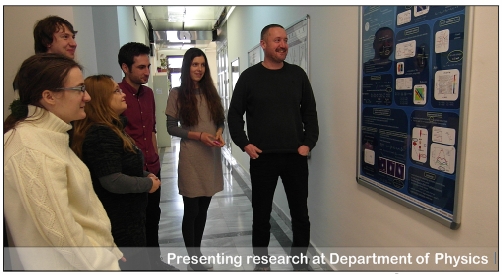O B A V I J E S T
IVANA LIHTAR
održat će znanstveni kolokvij (doktorski seminar) iz Nuklearne fizike pod naslovom
Constraining the nuclear symmetry energy from the Coulomb excitation of neutron-rich tin isotopes at relativistic energies
Relativistic Coulomb excitation of neutron-rich nuclei in inverse kinematics can be utilized to study the symmetry energy – a crucial, yet still fairly enigmatic ingredient of the nuclear equation of state. When projectile nuclei, accelerated to relativistic velocities, impinge on a high-Z target, collective Coulomb excitations arise where neutron and proton densities are displaced with respect to each other. Isospin imbalance forms in the system, which makes a suitable environment to probe the slope of the symmetry energy L, i.e. the linear coefficient in the expansion of the symmetry energy around the saturation density.
Motivated by this goal, an experiment was carried out at the GSI accelerator facility using the large acceptance spectrometer R3B-GLAD as a part of the FAIR Phase-0 campaign. Tin isotopes in the mass range A=124 − 134 were produced as a secondary beam in the fragmentation and fission reactions at energies of approximately 900 MeV/u. The Coulomb excitations were induced in a field generated by a lead target. Following deexcitation, the outgoing decay particles were detected using the R3B setup enabling the measurement of the Coulomb-excitation cross section σC , above the one-neutron separation threshold.
The σC has been shown to correlate with the dipole polarizability, αD , a well-established probe of the symmetry energy, due to their similar functional dependence on excitation energy. Leveraging this correlation between αD and L, the measurement of σC has recently been proposed as a viable alternative to challenging measurements of αD in radioactive nuclei [5]. With the described experiment, this possibility was further investigated. In this seminar, experimental results for σC in the isotopes 124Sn, 130Sn, and 132Sn will be presented, along with a comparison to theoretical predictions based on calculations employing a variety of relativistic and non-relativistic energy density functionals.
Seminar će se održati u utorak, 22. travnja 2025. godine u 10:00 sati u predavaonici F-201 Fizičkog odsjeka Prirodoslovno-matematičkog fakulteta Sveučilišta u Zagrebu.
Pozivaju se studenti doktorskog studija Fizike, smjer Nuklearna fizika, da prisustvuju seminaru, ako nisu spriječeni.
Voditelj smjera:
Prof. dr. sc. Damir Bosnar, v. r.


 Pristupačnost
Pristupačnost